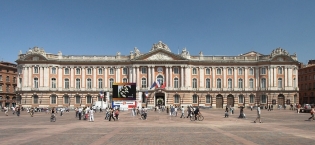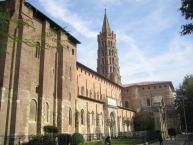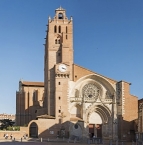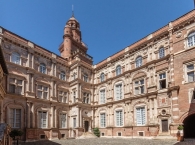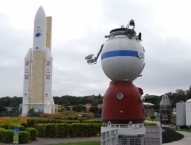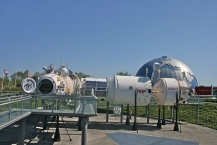Garonne-Radweg - von Toulouse nach Roquefort
Nr. des Radweges V83
Aktionen
![]()
Bitte warten - Kartendaten werden geladen
Erstellt am 04.01.2019,
zuletzt geändert von biroto-Redaktion am 10.03.2022
Aktionen
Strecken-Merkmale
Gesamtlänge in km
173
Informationen zu Rechten an den GPS-Track-Daten | |
|---|---|
Rechte-Inhaber | |
Rechte-Ausprägung / Lizenz | cc0: Public Domain keine Rechte vorbehalten |
Link zur Rechtebeschreibung | |
gpx-Datei hochgeladen | durch biroto-Redaktion am 10.03.2022
|
Gesamtzahl Trackpoints
2.938
Trackpoint-Dichte per km
17
Endorte
Start
Toulouse, Occitania, FR (139 m NHN)
Ziel
Fos, Occitania, FR (600 m NHN)
Fahrradfreundliche Unterkünfte, Sehenswertes und Infrastruktur
Name u. Anschrift
Breite / Länge
Tel.
Fax.
Mobile
Art d. Unterkunft
Radler-freund-lichkeit
Strecken-km
km zur Strecke
Höhe
2 km
1,5 km
138 m
4 km
1,7 km
153 m
4 km
0,6 km
141 m
Informationen zu Urheber-Rechten | |
|---|---|
Rechte-Inhaber | |
Rechte-Ausprägung / Lizenz | by-sa: CREATIVE COMMONS Namensnennung, Weitergabe unter gleichen Bedingungen |
Link zur Rechtebeschreibung | |
Bild übernommen aus | https://commons.wikimedia.org/wiki/File:Place_du_capitole_Toulouse_FRA_001_croped.jpg |
Bild hochgeladen | durch biroto-Redaktion am 16.02.2015
|
Informationen zu Urheber-Rechten | |
|---|---|
Rechte-Inhaber | |
Rechte-Ausprägung / Lizenz | by-sa: CREATIVE COMMONS Namensnennung, Weitergabe unter gleichen Bedingungen |
Link zur Rechtebeschreibung | |
Bild übernommen aus | https://commons.wikimedia.org/wiki/File:StSernin-10-2006.JPG |
Bild hochgeladen | durch biroto-Redaktion am 16.02.2015
|
Informationen zu Urheber-Rechten | |
|---|---|
Rechte-Inhaber | |
Rechte-Ausprägung / Lizenz | by-sa: CREATIVE COMMONS Namensnennung, Weitergabe unter gleichen Bedingungen |
Link zur Rechtebeschreibung | |
Bild übernommen aus | https://commons.wikimedia.org/wiki/File:Façade_de_la_cathédrale_Saint-Étienne_de_Toulouse.jpg |
Bild hochgeladen | durch biroto-Redaktion am 16.02.2015
|
Informationen zu Urheber-Rechten | |
|---|---|
Rechte-Inhaber | |
Rechte-Ausprägung / Lizenz | by-sa: CREATIVE COMMONS Namensnennung, Weitergabe unter gleichen Bedingungen |
Link zur Rechtebeschreibung | |
Bild übernommen aus | https://commons.wikimedia.org/wiki/File:Hôtel_d'Assézat_-_Main_courtyard_-_2014-09-01.jpg |
Bild hochgeladen | durch biroto-Redaktion am 16.02.2015
|
Toulouse [tuluːz] (okz. Tolosa [tuˈluzɔ]; die Einwohner heißen frz. Toulousains bzw. Toulousaines) ist eine Stadt am Fluss der Garonne .
In der Kernstadt leben 453.317 Einwohner, im Ballungsgebiet 892.115 Einwohner, und in der gesamten Metropolregion 1.250.251 Einwohner (2012).
Hintergrund
Toulouse war unter dem Namen Tolose eine wichtige gallische Stadt, welche sich damals acht Kilometer südlich bei Vieille-Toulouse befand. Hier trug sich 106 v. Chr. der Raub des Goldes von Tolosa durch Quintus Servilius Caepio zu. Toulouse wurde ab diesem Zeitpunkt eine wichtige Stadt des Römischen Reichs und Tolosa (lat.) genannt. Es war die Hauptstadt der Provinz Gallia Narbonensis zwischen Mittelmeer und Atlantik und hatte zwischen 20.000 und 50.000 Einwohner. Etwa im Jahr 8 v. Chr. wurden die Einwohner, vermutlich auf römischen Befehl, an die Stelle der heutigen Stadtmitte umgesiedelt. Seit dem 4. Jahrhundert war Toulouse Sitz des Erzbistums Toulouse. Zahlreiche Straßen in der Toulouser Innenstadt folgen noch dem Grundriss der römischen Siedlung.
413 wurde Toulouse Teil des Westgotenreichs. 418 schlossen die Westgoten einen Pakt mit dem römischen Kaiser. 507 kam es zur Niederlage des Westgoten und so zum Ende des Toulouser Westgoten-Königreichs. 721 wurde die Stadt in der Schlacht von Toulouse mehrere Monate von Arabern erfolglos belagert. Zwischen 781 und 843 war Toulouse Sitz des Königreichs von Aquitanien, danach erfolgte die Gründung der selbständigen Grafschaft Toulouse. In dieser Zeit war die Stadt Zentrum der Languedoc-Kultur.
1208 rief Papst Innozenz III. nach der Ermordung seines Legaten Pierre de Castelnau zum Kreuzzug gegen die Albigenser auf. Der Aufruf hatte Erfolg. Die Stadt wurde geplündert. 1228 gab Graf Raimund VII. von Toulouse nach einem zermürbenden und zerstörerischen Krieg von fast 20 Jahren den Widerstand auf und unterschrieb den Vertrag von Paris (1229).
1271 wurde Toulouse unter die Herrschaft der französischen Krone gestellt, blieb jedoch bis 1790 weitgehend unabhängig. Obwohl zur Zeit der Reformation viele Protestanten in Toulouse lebten, stellte sich die Stadt in den Religionskriegen auf die römisch-katholische Seite. 1562 wurden ca. 4000 Hugenotten ermordet.
In der Renaissance (etwa 1450 bis 1550) zählte Toulouse zu den reichsten Städten Frankreichs. Pastel (isatis tinctoria), eine Pflanze, die damals den einzigen beständigen blauen Farbstoff lieferte, gedieh auf den kalkhaltigen Böden des südöstlich der Stadt gelegenen Lauragais besonders gut. Bedeutende Profanbauten der Pastelgroßhändler im Renaissance-Stil, wie beispielsweise das Hôtel d’Assézat oder das Hôtel de Bernuy, entstanden in dieser Zeit.
Von 1444 bis 1790 war Toulouse der Sitz des parlement de Toulouse, welches für einen großen Teil Südfrankreichs zuständig war und dort im Auftrag der Krone Legislative, Jurisdiktion und Exekutive ausübte.
Im 19. Jahrhundert nahm Toulouse an der Industrialisierung Frankreichs kaum teil. 1856 bekam Toulouse einen Anschluss an das französische Eisenbahnnetz. Die Stadt wuchs und veränderte sich mit dem Bau der großen Boulevards wie zum Beispiel rue Alsace-Lorraine und rue de Metz. 1875 wurde Toulouse von der Garonne überschwemmt. Seit den 1920er Jahren deutete sich die Entwicklung der Flugzeugindustrie in der Stadt an.
Sehenswürdigkeiten
Toulouse wird aufgrund seiner zahlreichen Bauwerke aus roten Ziegelsteinen auch la ville rose –„rosarote Stadt“- genannt. Bekannte Sehenswürdigkeiten der Stadt sind:
- Canal du midi
, der Kanal verbindet Toulouse mit dem Mittelmeer und ist UNESCO-Welterbe
- ⊙ gotische Kathedrale Saint Etienne (begonnen um 1272)
- ⊙ altes gotisches Dominikanerkloster Les Jacobins. In der ehemaligen Hauptkirche des Dominikanerordens mit den berühmten palmier des Jacobins (kunstvolles gotische Deckengewölbe) befindet sich - mit Unterbrechung - seit 1369 auch die Grabstelle des Hl. Thomas von Aquin. Angeschlossen daran ist der im selben Stil erbaute Kreuzgang.
- ⊙ Kapitol (Rathaus von Toulouse), mit Turm (Donjon) aus dem 16. Jh. und Fassade aus dem 18. Jh. Im Inneren der Salle des Illustres (Prunksaal mit Deckengemälden) und berühmtes Opernhaus Théâtre du Capitole im südlichen Seitenflügel.
- Médiathèque José Cabanis, eine im Jahr 2003 eröffnete multimediale Bibliothek in modernem Bau.
- viele Patrizierhäuser im Renaissance-Stil wie beispielsweise das Hôtel d’Assézat oder das Hôtel de Bernuy.
- ⊙Pont Neuf
, die älteste noch erhaltene Brücke über die Garonne in Toulouse, erbaut 1543 bis 1632.
- ⊙ romanische Basilika St-Sernin de Toulouse
(11.–12. Jahrhundert), die zu den schönsten romanischen Kirchen Südfrankreichs gehört, seit 1998 UNESCO-Welterbe
Museen
- Centre de l'Affiche, ein Museum über die Geschichte von Postern und Plakaten
- Cité de l’espace
, ein interaktives Museum der ESA über die Raumfahrt, Umwelt und das Universum.
- Musée d'Histoire naturelle, ein naturgeschichtliches Museum über Tierarten, die Entwicklung der Welt und unsere Umwelt, mit botanischem Garten
- Musée des Abattoirs, ein Museum für moderne und zeitgenössische Kunst, untergebracht im ehemaligen Schlachthof der Stadt
- ⊙ Musée des Augustins, Kunstmuseum für romanische bis barocke Kunst. Dieses seit 1793 im Augustinerkoster untergebrachte Museum bietet die Gelegenheit zu einem Rundgang in einem der schönsten Klosterbauten des 14. und 15. Jh.
21 Rue de Metz, ☎ +33 561 222182, Einritt Erw. 5 €, täglich von 10:00 bis 18:00 Uhr, mittwochs von 10:00 bis 19:00 Uhr, dienstags geschlossen. - ⊙ Musée du Vieux Toulouse, ein Museum über die antike Geschichte von Toulouse
7 Rue du May, ☎ +33 562 271150, Einritt Erw. 4 €, von Mitte April bis November Montag bis Samstag von 14:00 - 18:00 Uhr. Sonntags und an Feiertagen geschlossen. - Musée Georges Labit, das neben römischen Arbeiten auch ägyptische, koptische, chinesische und japanische Kunstwerke zeigt.
- ⊙ Musée Saint-Raymond, das in der Nähe der Basilika Saint Sernin liegt. Im Keller sind Teile der ausgegrabenen Nekropole aus römischer und frühchristlicher Zeit zu sehen. In den oberen Stockwerken befinden sich Funde aus archäologischen Ausgrabungen aus dieser Zeit.
1 Ter Place Saint-Sernin, ☎ +33 561 223144, Eintritt Erw. 4 €, täglich von 10:00 bis 18:00 Uhr
Informationen zu Urheber-Rechten | |
|---|---|
Rechte-Ausprägung / Lizenz | by-sa: CREATIVE COMMONS Namensnennung, Weitergabe unter gleichen Bedingungen |
Link zur Rechtebeschreibung | |
Text(e) übernommen von: |
Seite „Toulouse“. In: Wikipedia, Die freie Enzyklopädie. Bearbeitungsstand: 1. Februar 2015, 19:23 UTC. URL: http://de.wikipedia.org/w/index.php?title=Toulouse&oldid=138398027 (Abgerufen: 16. Februar 2015, 16:49 UTC) |
übernommen / bearbeitet am | 16.02.2015 - 10.09.2016
|
übernommen / bearbeitet durch |
|
4 km
4,7 km
128 m
Informationen zu Urheber-Rechten | |
|---|---|
Rechte-Inhaber | |
Rechte-Ausprägung / Lizenz | cc0: Public Domain keine Rechte vorbehalten |
Link zur Rechtebeschreibung | |
Bild übernommen aus | https://commons.wikimedia.org/wiki/File:France-Toulouse-Cite_de_l'espace-Ariane_5.jpg |
Bild hochgeladen | durch biroto-Redaktion am 16.02.2015
|
Informationen zu Urheber-Rechten | |
|---|---|
Rechte-Inhaber | |
Rechte-Ausprägung / Lizenz | by-sa: CREATIVE COMMONS Namensnennung, Weitergabe unter gleichen Bedingungen |
Link zur Rechtebeschreibung | |
Bild übernommen aus | https://commons.wikimedia.org/wiki/File:Mir_replica_at_Cite_de_l'Espace_1.jpg |
Bild hochgeladen | durch biroto-Redaktion am 16.02.2015
|
Die Cité de l’espace, auf deutsch etwa „Weltallstadt“, ist ein Themenpark in der südfranzösischen Stadt Toulouse , der europäischen Hauptstadt der Luftfahrt und Raumfahrt.
Die Cité de l’espace ist eine wichtige Sehenswürdigkeit von Toulouse und wurde 1997 eröffnet. Sie ist eine Mischung aus Themenpark und Erlebnispark. Es wird viel Wissenswertes über das Sonnensystem, Satelliten bis zur jüngsten Weltraumstation dargestellt und zum Teil zum Ausprobieren angeboten.
Attraktionen
Schon von weitem sieht man den genauen Nachbau der Ariane 5, der wie die echte Rakete 55 Meter hoch ist. Die Ariane überragt den auf 3,5 Hektar angelegten Park mit 2000 m² Ausstellungsfläche.
Im Hauptausstellungsgebäude ist die Entwicklung der Weltraumeroberung zu entdecken und die Fortschritte der Forschung nachzuvollziehen. Interaktive Systeme stellen plastisch dar, wie Satelliten gebaut und ausgesetzt werden, wie die Wettervorhersage funktioniert, wie die Telekommunikation das Leben erleichtert und die Pioniere all dieser Bereiche ihre Erfindungen gemacht haben. Modelle von Mir-Modulen zeigen bis ins Detail das Alltagsleben der Astronauten.
Ein IMAX-Kino mit einem von den Astronauten der ISS gedrehten Film, ein Planetarium sowie eine Welthalbkugel, in der man dank einer dreidimensionalen Videoprojektion in die Vergangenheit reist und die Entwicklung der Erde vom Urknall bis zur Gegenwart verfolgen kann, gehören zu den Hauptattraktionen.
Die Cité de l’espace wurde von der der Stadt Toulouse in Zusammenarbeit mit dem Verkehrsministerium, dem Kulturministerium, der französischen Raumfahrtagentur CNES, EADS, ASTRIUM und vielen anderen realisiert.
Informationen zu Urheber-Rechten | |
|---|---|
Rechte-Ausprägung / Lizenz | by-sa: CREATIVE COMMONS Namensnennung, Weitergabe unter gleichen Bedingungen |
Link zur Rechtebeschreibung | |
Text(e) übernommen von: |
Seite „Cité de l’espace“. In: Wikipedia, Die freie Enzyklopädie. Bearbeitungsstand: 17. September 2014, 19:58 UTC. URL: http://de.wikipedia.org/w/index.php?title=Cit%C3%A9_de_l%E2%80%99espace&oldid=134124168 (Abgerufen: 16. Februar 2015, 17:12 UTC) |
übernommen / bearbeitet am | 16.02.2015
|
übernommen / bearbeitet durch |
|
Öffnungszeiten
Most days at least from 10 am to 5 pm, some days open until 11 pm. Some days closed.
Check it on the Website.
4 km
1,1 km
147 m
![]()

